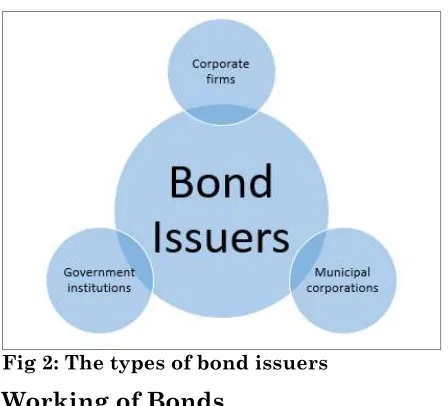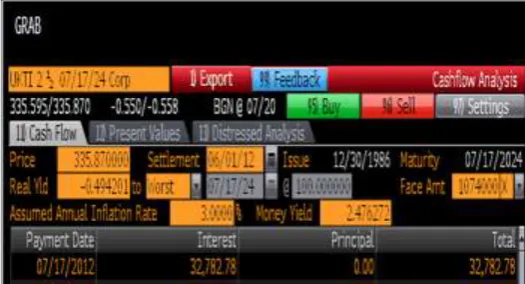ISSN: 2278-3369 International Journal of Advances in Management and Economics
Available online at: www.managementjournal.info
RESEARCH ARTICLE
Bonds Reconciliation of Entitlement of Shares in Investment
Banking
Vedapradha R, Hariharan Ravi*
Department of Commerce and Management, St. Joseph’s College of Commerce, Bangalore, India.
Abstract
Bonds refer to a debt instrument which is issued by the financial institutions to finance various projects and activities. The central banks of various nations, large government financial institutions focus on capitalising on these securities due to credit worthiness and less risk factors. The portfolio is reconciled between custodian and investment banking firm on daily basis to verify the accuracy of books of accounts for cash and stock held. The purpose of this research is to identify the reasons and associated comprehensions for the discrepancies in books of accounts between custodian and investment banking firms in coupon due to entitlement of shares held at either of parties.
Keywords:Entitlement, Bonds, OTC, SWIFT, Coupon and Reconciliation.
Introduction
Investment refers to the sacrifice of current usage of financial resources and money applied on any other financial assets with expectation of income being generated in the future. Bonds refer to a debt instrument which is issued by the financial institutions to finance various projects and activities. The financial institution issuing the instrument is known as issuer and the party buying the same is known as bond holder. It is a debt agreement promising to repay the money after definite period of time during which a fixed rate of interest is paid to the holder by the issuer. They are also known as fixed income securities and are one of the three major asset classes along with stock and cash equivalents in the organised markets.
Credit quality and duration of the bond are the primary determinants of a bond’s interest rate. The riskiness of bond portfolios are typically evaluated by the investors on the price sensitivity to changes in interest rates and duration of the bond. Bond maturities can range from a day or less than 30 years. The longer the bond maturity or duration, the greater the chances of adverse effects of liquidity and credibility paying highest ineptest rates. Bonds are bought and traded mostly by institutions like central banks and financial institutions.
The investment banking firms often have two broad classification of strategies with respect to portfolio management namely active and passive strategies.
Active strategy always aims at portfolio generating returns above the benchmark proportionate with risk associated. Passive strategy aims at portfolio always trying to match the benchmark with reasonable returns to the investors. There are various other sub grouping of strategies within bonds operated in the financial market like quasi active and quasi passive etc.
Features of Bond
The bonds comprises of below features.
Available online at www.managementjournal.info
Original Face value: The value which is quoted on the debt instrument and worth at its maturity which is the basis for calculating the interest payable. It is also known as principal value.
Current face value: The value which is outstanding as on particular date with respect to pay down bonds where the principal amount is payable to the bond holder at periodical intervals.
Coupon: The fixed or floating rate of interest that is payable by the issuer to the bond holder on the face value always represented as a percentage.
Maturity date: The date on which the bond gets matured and is due by the issuer to the bond holder as per the face value of the bond.
Issue price: The price at which the issuer originally sells the bond.
Accrued interest: The coupon amount which gets accumulated that is calculated on the face value of the bond until the coupon’s payable date.
Bond Issuers
Bonds are issued by three major groups’ namely corporate companies, municipal corporations and government institutions. Corporate bonds are issued by the corporate houses, municipal bonds are issued by local bodies and state government and central government issues US treasury bills.
Fig 2: The types of bond issuers
Working of Bonds
The companies or other entities issue bond when they raise finance for various projects, working capital requirements or refinance
existing other debts directly to investors instead of obtaining loans from the banks. The indebted entity (issuer) issues a bond that contractually states the interest rate that will be paid and the time at which the debt instrument will be returned. Most of the corporate and government bonds are traded in bond market whereas the others traded only on OTC (Over the counter).
Pricing of Bonds
The actual market price of a bond depends on a number of factors including the credit quality of the issuer, the length of maturity and the coupon rate compared to the general interest rate environment in the market.
Features of Coupon
The following are the features of the coupon
Coupon rate-The rate which can be fixed or floating is used as a percentage to compute the total amount of coupon payable.
Frequency-The number of times coupon is payable on the bond security with intervals. Usually it is payable annually, semi-annual, quarterly or monthly.
Pay date-The security is expected to receive coupon on a specific date on which coupon is due to be paid.
Ex/record date-This is the date on which coupon payable date is confirmed by the board of directors.
Entitled shares-The number of shares on which the coupon is payable on the basis of buy or sell trades with the bond holder as per the settle date and coupon date.
Trading of Bonds
Investment banking firms comprises of front end office where portfolio managers are responsible for booking the trades based on the availability of stock and cash balance in each portfolio or through an authorised broker. Portfolio manager books the trade of a particular security (either buy or sell) through vendor like Bloomberg. The same details of the booked trade are communicated to both custodian and broker with details of the ticker through SWIFT (society for
worldwide interbank financial
trade booked at the portfolio manager or brokers. The information is further cascaded in respective accounting systems of custodian, investment banking firms and brokers. Trades usually settle at the clearing houses on T+3 days (Trade date + 3 days). Trade value of a bond is always as below:
Reasons
for
Discrepancies
in
Reconciliation between Custody and
Investment Banking Firms
There are various reasons due to which there arise discrepancies between custody and investment banking firms in reconciliation. These differences affect both cash and stock position in each portfolio. Some of the common reasons are:
Table 1: Common reasons for discrepancies in cash and stock between custody and investment banking firm
Cash Positions
Coupons Trades
With holding of tax Pay downs
Incorrect coupon at investment banking firm STIFS/Income sweeps
Incorrect coupon at custody Inflated positions
Coupon rate Multi listed securities
Entitlement issue Mapping of securities
Pay date Fractional shares
Trades Corporate actions
Pay downs Future contracts
Income repatriation Fail trades
Clearing houses Rounding of shares
Calculation of Shares Entitled with
Respect to Coupons
A coupon calculation varies between Custody & Investment banking firm with respect to MPF (Mandatory provident funds) & Inflation linked securities due to shares entitled at either of them is incorrect.
Entitlement of Shares
Investment banking firm is entitled for a share only when below clause is completed. “Trades for the month (beginning of the month till the pay date of coupon) in which coupon is payable should have settled with positive accrual interest”.
Analysis in Calculating Entitlement of Shares Based on Type of Trade
Buy trades: In general when if there is a buy trade then the holdings or shares gets increased (Original+ No of shares bought). Sell trades: If there is a sell trade then the
holding gets decreased (Original – No of shares sold).
Accrued interest: The accrued interest on either buy or sell trade should always be positive (positive means always greater than “zero”)
Settle Dates: The settle date of the trade booked should be always prior to the coupon date. All the trades booked prior to coupon date should have settled before the pay date of coupon.
Calculation of Entitled Shares
Entitlement of shares = Original face value of security + Total No of shares bought till the pay date of coupon – Total No of shares sold till the pay date of coupon.
Analysis
Original face value – original face value of the security can be obtained from OC holdings report in accounting system.
o Total No of shares bought till the pay date of coupon
If a Buy trade is settled with positive accrued interest more than Zero & the settle date of the trade is before the pay date of coupon then IGNORE the No of shares because the trade is settled & accrual is paid along with the total trade amount. There is No separate coupon to be received on those shares. In this Investment banking firm is entitled for the shares.
Available online at www.managementjournal.info Holdings: Increases
Buy trade has below then Investment banking firm is not entitled for those shares of the trade.
• Trade with negative accrued interest
• Settle date of trade is on or after pay date of coupon
• Accrued interest is Zero.
Holdings: Decreases
o Total No of shares sold till the pay date of coupon
If a sell trade is settled with positive accrued interest more than Zero & the settle date of the trade is before the pay date of coupon then IGNORE the No of shares because the trade is settled & accrual is paid along with the total trade amount. There is No separate coupon to be received on those shares. In this Investment banking firm is entitled for the shares.
Holdings: Decreases
If a sell trade has below then Investment banking firm is not entitled for shares of the trade.
• Trade with negative accrued interest • Settle date of trade is on or after pay date
of coupon
• Accrued interest is Zero.
Table 2: Analysis of entitled shares on which coupon is calculated
Holdings: Increases
Steps to calculate the entitlement of shares on a security with an assumed example Security ID XYZ on the fund ABCD at a coupon rate 2.5 per cent . Issued 12/30/86
Fig 3: Screenshot of Bloomberg
In this security, there are 4 trades booked when considered from 1st July 2012 to pay date of coupon (07/17/2012). Issued on 12/30/86. Maturity on 07/17/2024.
Table 3: No of trades booked from the beginning of July till coupon date
Below is the analysis of trades
Calculation of entitled shares – Shares not entitled on trades
Table 5: The net effect of total number of trades with respect to shares
Type Shares
Sell 250,000
Sell 4000
Buy (2000)
Sell 1000
Net Effect 253,000
In this example if you see, there is No original face value when report extracted from accounting system.
Assume custody is reflecting 1,074,000 shares & Investment banking firm 821,000 on reconciliation tool. The difference is 253,000 shares which is exactly the impact of shares not entitled as per trades calculated above.
Table 6: The net effect of trades in
comparision between cutsody and
investment banking firm
Custody shares 1,074,000
Investment banking
firm shares on recon tool
(821,000)
Net effect 253,000
Accounting system has just considered the NET effect of total buy & sell trades arriving without actually calculating if we are entitled on shares of that trade or not. Hence the entitled shares when you detail
coupon at Investment banking firm matches to shares posted at custody but not on reconciliation tool.
When you check the coupon for 1,074,000 on any of the globally accepted vendors like IDC, Bloomberg, Euroclear etc, Custody matches.
Coupon Discrepancy
Table 7: Difference in coupon amount calculation
Investment banking firm
coupon 25,060.20
Custody coupon 32,782.78
Difference 7,722.58
When custody matches vendor as per calculation of entitled shares & euro clear, Investment banking firm has to make income adjustment in their accounting system to match custody.
Conclusion
Operational levels of investment banking firms are one of the major sources of employment across globe. These consist of reconciliation as part of the back end activities.
Reconciliation ensures there is accuracy in books of accounts between custodian and the investment banking firms on a daily basis.
The common discrepancies which arises during reconciliation includes settlement date of a particular trade, non-settlement of trades at clearing houses, entitlement of shares held at both parties etc.
Coupon on the bond security is always calculated on the number of shares held on inflated linked securities or mandatory pension funds most often traded in European countries.
These discrepancies result in either over or under receipt of coupon settling on a particular security at either or parties for the reason that custodian always records the transactions in their accounting system on real time basis and investment banking firm on contractual basis.
Hence it becomes important to identify and analyse the way the coupon are calculated when there is entitlement of shares that facilitates reconciliation to progress smoothly.
Bonds are popularly invested on European and US countries for better portfolio management services, foreign exchange rate stability, tax benefits and credit worthiness.
Settle date of the trade plays an important role in deciding the eligibility of coupon to the holder or seller based on the acceptance of accrued interest of trade. The financial institution issuing the
instrument is known as issuer and the party buying the same is known as bond holder. Investment banking firms invests in bonds as these are the excellent source of fixed income generating securities to various large financial institutions.
Available online at www.managementjournal.info management services, foreign exchange
rate stability, tax benefits and credit worthiness.
Fixed income asset class in leading investment banking firms generating fixed
income to various groups of institutional investors and also to facilitate the reconciliation wing to operate smoothly in analysing the discrepancies [1-20].
References
1. Frank J Fabozzi and Steven V Mann, “The handbook of fixed income securities”. 7th
edition. McGraw- Hill.
2. Vedapradha R (2016) Investment banking-A panacea for economic development in banking sector”. International Journal of business
quantitative economics and applied
management research. Vol 3. Issue 4.
3. Roberto Blanco (2005) An empirical analysis of the dynamic relation between investment grade bonds and credit default swaps”. Journal of finance, Vol No 5.
4. Alexande (1998) Trading volume and liquidity in NASDAQ’s high yiled bond market. Unpublished manuscript, Securities and Exchange Commission, Washington DC. 5. Baillie (2002) Price discovery and common
factor models”. Journal of financial markets. Vol 5.
6. Philip Turner (June 2002). “Bond markets and banks in emerging economies – An overview of policy issues”. Bank for international settlements. Vol 11.
7. Allen F, D Gale (2000) “Comparing financial system”. MIT press. Cambridge.
8. APEC (1999) Compendium of sound practices. Guidelines to facilitate the development of domestic bond markets in APEC member countries.
9. Merrill Lynch (2002) World bond market Aril report.
10. John Hawkins (2002) Bond markets and banks in emerging economies. Bank for international settlements. Vol 11.



